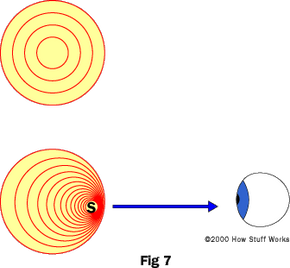The Doppler Effect
The Doppler Effect basically says that there is an observed frequency shift in electromagnetic waves due to motion. The direction of the shift is dependent on whether the relative motion is traveling towards you or away from you (or vice versa). Also, the amplitude of the shift is dependent on the speed of the source (or the speed of the receiver). A good place to start in understanding the Doppler effect would be to first look at sound waves. There is a Doppler Shift associated with sound waves that you should recognize easily. When a sound source approaches you, the frequency of the sound increases and likewise, when the sound source moves away from you, the frequency of the sound decreases. Think about an approaching train blowing its whistle. As the train approaches, you hear the whistle tone as a high note. When the train passes you, you can hear the whistle tone change to a lower note. Another example occurs when cars race around a racetrack. You can hear a definite shift in the sound of the car as it passes where you are standing. One last example is the change in tone you hear when a police car passes you with its siren on. I'm sure that at some point in our lives, all of us have imitated the sound of a passing car or passing police car; we imitated the Doppler Shift. This Doppler shift also affects light (electromagnetic radiation) in the same manner with one critical exception; the shift will not allow you to determine if the light source is approaching you or if you are approaching the source and vice versa for moving away. This being said, let's look a fig 7 below.
In the top part of fig 7 you can see a stationary light source is emitting light in all directions. In the second part, you can see that source "S" is moving to the right and the light waves are shifted (they look as though they are being compressed in the front and dragged in the rear). If you approach the light source or the light source approaches you, the frequency of the light will appear to increase (notice that the waves in the front are closer together than in the rear). The opposite is true for a light source that is moving away from you or that you are moving away from. The importance of the frequency change is that if the frequency increases, then the time it takes for one complete cycle (oscillation) is less. Likewise, if the frequency decreases, the time it takes for one complete cycle is more.
Advertisement
Now let's apply this information to the Twin Paradox. Recall that John sped away from Hunter at 60% the speed of light. I picked this speed, because the corresponding relativistic Doppler shift ratio is "2 times" for an approaching source and "1/2" for a source that is moving away. This means that if the source is approaching you, the frequency will appear doubled (time is then halved) and if the source is moving away from you, the frequency will appear halved (time is then doubled). (similarly I could have used any speed for the paradox; for example, 80% the speed of light would have led to a Doppler shift of "3" and "1/3" for approaching and moving away respectively). Remember, the direction of the shift is dependent on the direction of the source, while the amplitude of the shift increases with the speed of the source.
We'll look at the Doppler shift in the next section.
